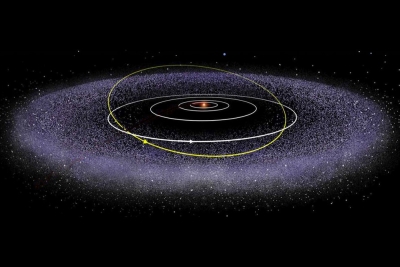
Also called the “third zone” of the solar system, this large volume of space outside Neptune’s orbit is home to thousands of icy, cold objects. This is where Pluto is also present.
In the cold, outermost area of our solar system lies one of the largest structures in our solar system. Also called the “third zone” of the solar system, this “donut-shaped” volume of space is called the Kuiper belt. This is where Pluto is also present.
The region encompasses hundreds of thousands of icy, cold objects and is outside Neptune’s orbit.
The region is named so after astronomer Gerard Kuiper, who published a paper speculating objects beyond Pluto. This was also suggested by Astronomer Kenneth Edgeworth in the papers he published and sometimes this belt is called the Edgeworth-Kuiper Belt. Some researchers also refers to it as the Trans-Neptunian Region.
The icy bodies are called Kuiper Belt Objects (KBOS) or trans-Neptunian objects (TNOS). They are highly diverse in terms of size, shape, and colour. A significant number of KBOS have moons.
So how did the icy objects form? According to scientists, these icy objects are leftovers after the formation of our solar system. The region must have formed after these objects came together to form a planet but Neptune’s gravity played spoilsport. The gravity shook up this region and these icy objects couldn’t join to form a planet.
The Kuiper Belt volume is being lost nowadays. The amount of material which it carries now is much less when compared to what it contained earlier.
The objects in the belt collide and lead to fragmented, smaller objects. Sometimes the dust gets blown out of the solar system. We take a look at a few of the KBOS.
Haumea
This KBO is known for its strange shape and rotation style. According to NASA, the Haumea resembles a squashed American football. This was a result of the object’s collision with another object half the size of it.
Eris
Smaller than Pluto, Eris takes 557 years to orbit the Sun. It has a moon called Dysnomia.
Arrokoth
Lying some billion miles past Pluto is the Arrokoth, a Kuiper Belt Object which means sky in the Native American language. This small snowman-shaped object is believed to hold clues about the origin of life on Earth and also about the planet’s formation.
Picture credit : Google




